31 Types Of WATER BIRDS in Florida (ID Guide With Photos)
Did you recently spot a water bird in Florida? In that case you’ll probably want to know what species you saw.
Identifying the water bird species of Florida is not as easy as you might think, since there are many different types of aquatic birds that live in the Sunshine State.
To help you identify the bird you saw, we’ll cover the common water birds of Florida in this article.
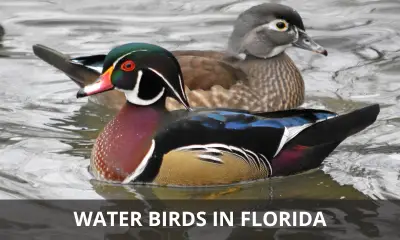
What types of water birds are found in Florida?
There are 31 types of water birds commonly found in Florida, which are described in full detail below.
Mallard
Scientific name: Anas platyrhynchos
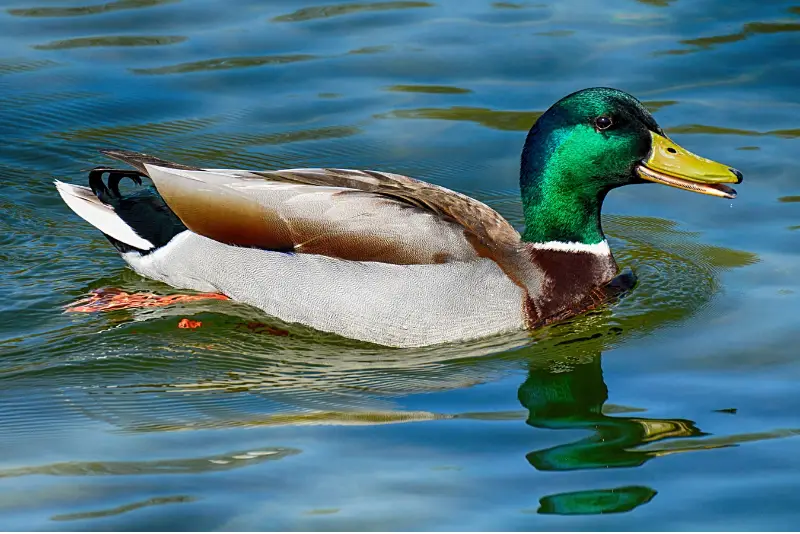
Mallards are the most common type of duck in Florida, and actually the most common ducks in the whole of North America for that matter.
These ducks are extremely well adapted to man made habitats, and are often found on ponds and lakes in suburban parks.
Male Mallards can be recognized by their glossy green head and bright yellow beak, while females are uniformly mottled brown
Mottled Duck
Scientific name: Anas fulvigula
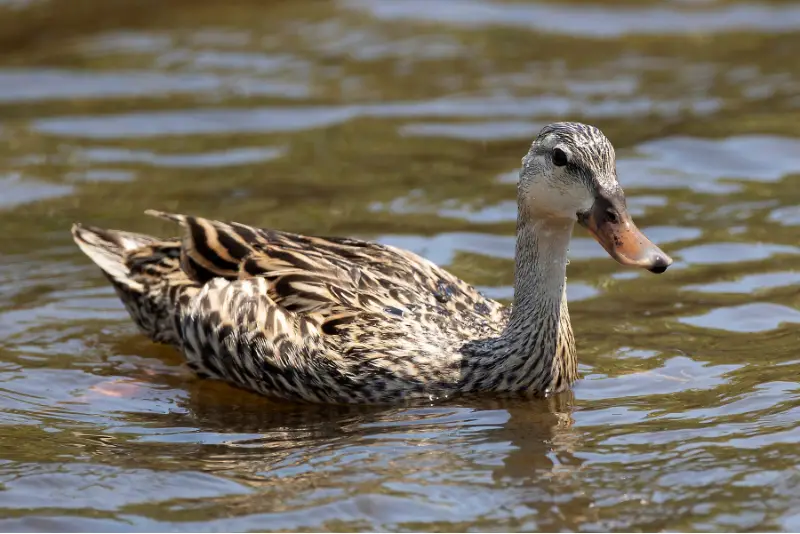
Mottled Ducks are breeding birds in Florida and the coastal areas of the Gulf of Mexico.
Both males and females look superficially similar to female mallards, but can be distinguished by their gray head and neck, as well as their dark eyestripe.
These waterfowl are common in many wetland habitats across Florida, but because they frequently mate with mallards it’s quite common to observe hybrids (called “Muddled Ducks”).
American Wigeon
Scientific name: Mareca americana
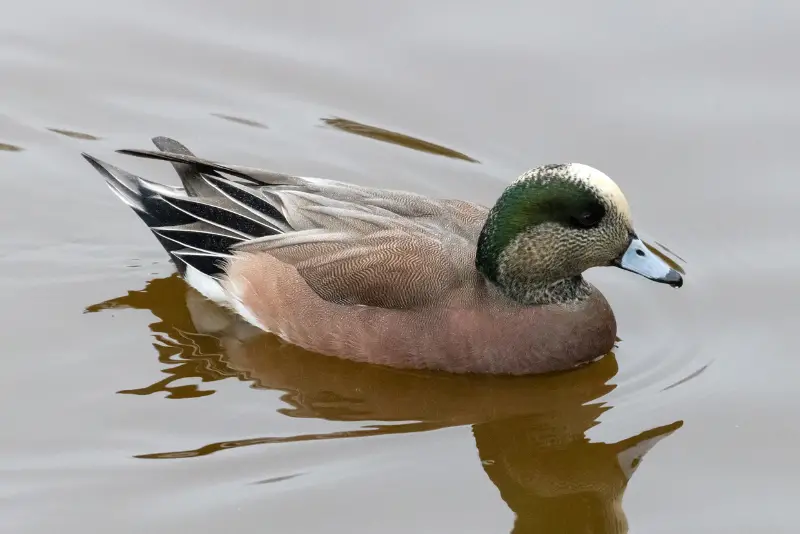
American Wigeons are winter visitors in the state of Florida, where they can be seen from September through April.
Males can be recognized by their dark green eyepatch and white crown, while females are more inconspicuous and largely brownish gray.
They forage on ponds, lakes, marshes and harvested fields. However, they tend to be very wary, and you’ll need a good spotting scope to observe them from a distance.
Canvasback
Scientific name: Aythya valisineria
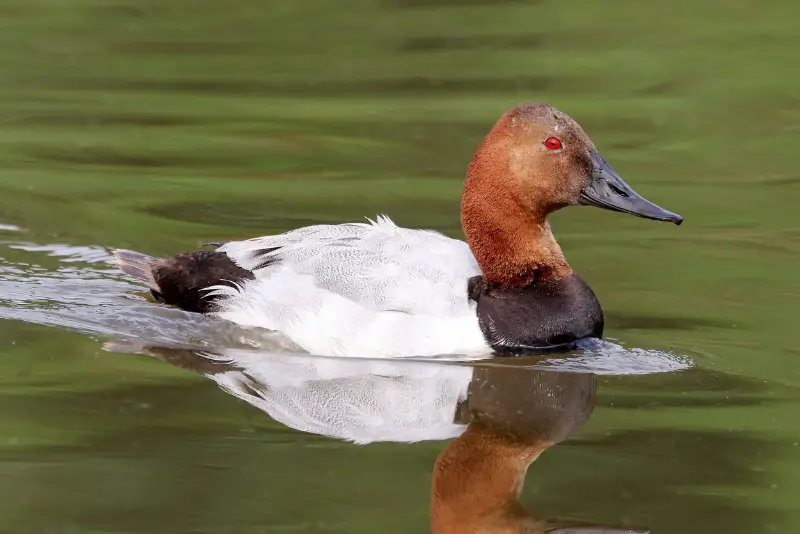
The Canvasback is a type of diving duck that feeds by eating tubers and plants from the bottom of ponds and lakes.
The male is easily recognized due to its dark chestnut head with red eyes, light gray body, black chest, and black tail.
Females look similar, but are more muted in their colors. These ducks winter in northern Florida from October to April.
Northern Shoveler
Scientific name: Spatula clypeata

The male Northern Shoveler is one of the most colorful waterfowl found in North America. It has a white chest, green head, chestnut flanks, and dark wings with a light blue patch.
Both sexes are also easily recognized by their oversized, flattened bill, which they use to filter small aquatic invertebrates and plant seeds out of the water.
Northern Shovelers winter throughout Florida, and can be seen in the state from September to April.
Blue-winged Teal
Scientific name: Spatula discors

Adult male Blue-winged Tealshave a powdery blue forewing, as well as a dark green rear margin of the wing. This coloration is most clearly seen in flight.
These small ducks prefer marshland and ponds, and can be seen in saltwater and brackish water habitats outside of the breeding season.
They are regular winter visitors in Florida, but migrate to Canada and the northern USA during the summer.
Wood Duck
Scientific name: Aix sponsa

The Wood Duck is another stunningly colored duck species that breeds in Florida and is a year-round resident in the Sunshine State.
Wood Ducks live in wetlands that are adjacent to woodland habitats, as they nest in tree holes.
They also accept nest boxes, which can be used to attract them to areas lacking suitable nest holes.
Snow Goose
Scientific name: Anser caerulescens
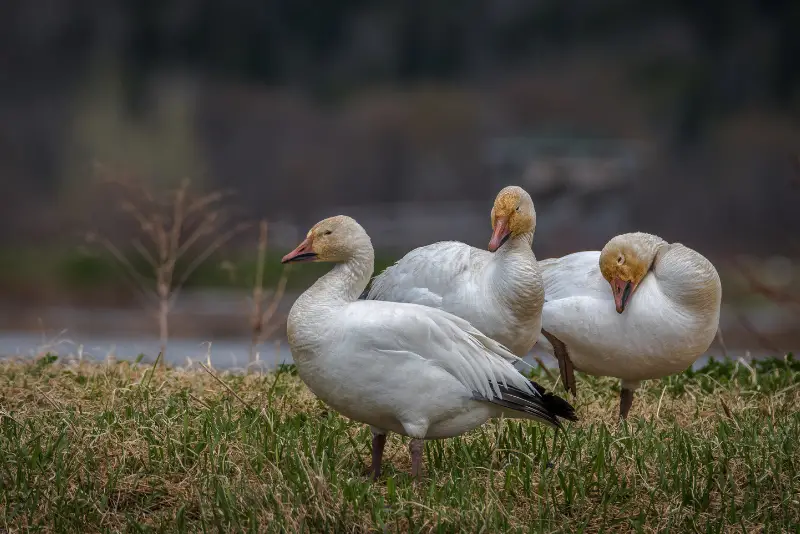
Similar to Trumpeter Swans, Snow Geese are winter visitors in Florida, but the number of wintering Snow Geese has rapidly increased in recent years.
While Snow Geese were formerly rare winter visitors in Florida, these birds are now commonly seen in the winter throughout the state.
Wintering Snow Geese can be seen all over Florida, but are most commonly found in the eastern part. These birds arrive in October, and most of them leave by March.
Canada Goose
Scientific name: Branta canadensis

The Canada Goose is one of the most easily recognizable aquatic birds, due to its white cheeks that contrast with its jet black neck and head.
They are breeding birds in Canada and northern States, and fly south every fall in large V formations that herald the start of the cold season.
Canada Geese are year-round residents in northern Florida, and sometimes show up as vagrants in other parts of the state.
Great Blue Heron
Scientific name: Ardea herodias
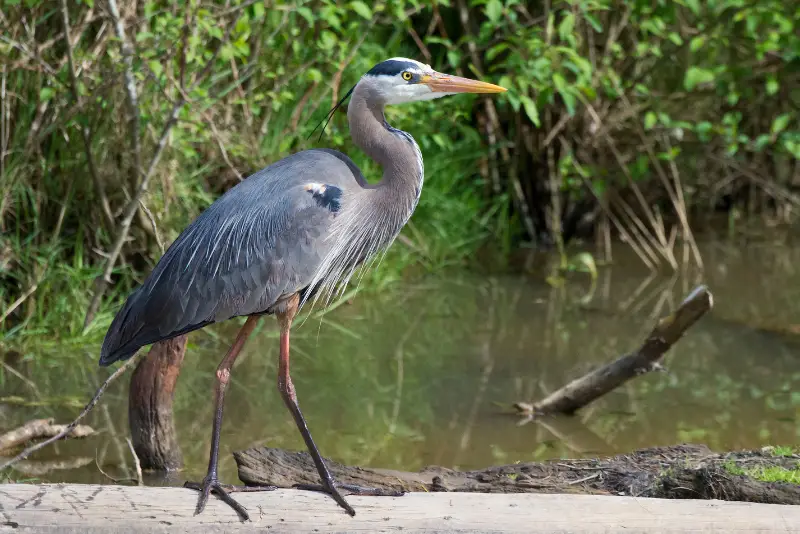
The Great Blue Heron is one of the most common herons found in the Sunshine State, where it can be seen year round.
With a wingspan of up to 6 feet, this heron is one of Florida’s big birds. It is almost entirely blue gray, except for a white throat and eye stripe, as well as dark gray wing feathers.
Great Blue Herons can be found in many wetland habitats. You can find them in both saltwater and freshwater marshes, flooded fields, mangrove swamps, and lake shorelines.
Great Egret
Scientific name: Ardea alba
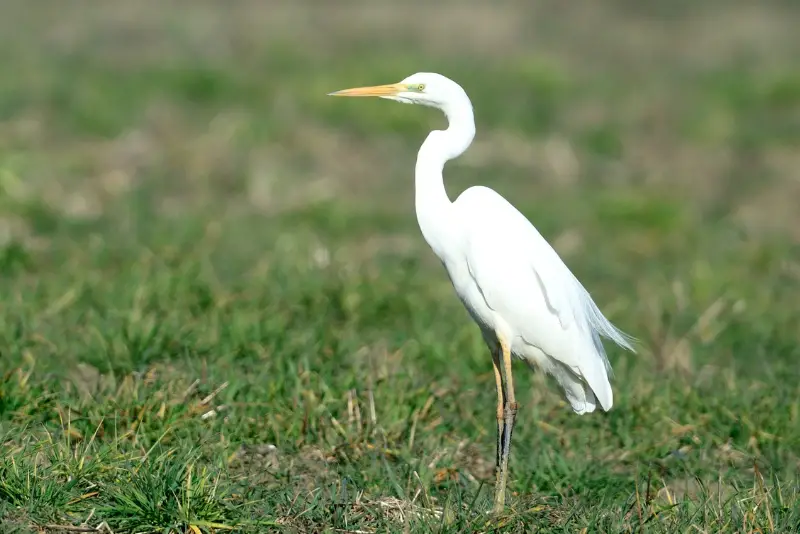
The Great Egret is one of the most common heron species in Florida, and outside of the state it has a range that spans nearly the whole planet.
This Florida bird is largely white, except for its long, black legs and yellow beak.
This heron lives in both fresh and saltwater habitats, and often nests in large colonies on the shores of marshes, lakes, and rivers.
Great Egrets forage in any type of shallow water bodies, including ponds, lakes, rivers, estuaries, as well as rice fields and other flooded areas.
Green Heron
Scientific name: Butorides virescens

The Green Heron is a relatively common water bird species in Florida. It’s a medium-sized heron with an olive-green body and black wings.
These herons tend to live near water, so they’re often seen around lakes, rivers, ponds, or even swimming pools.
They eat fish, frogs, snails, small reptiles, amphibians, and crustaceans. They nest in trees or shrubs but sometimes build their nests on islands.
Little Blue Heron
Scientific name: Egretta caerulea
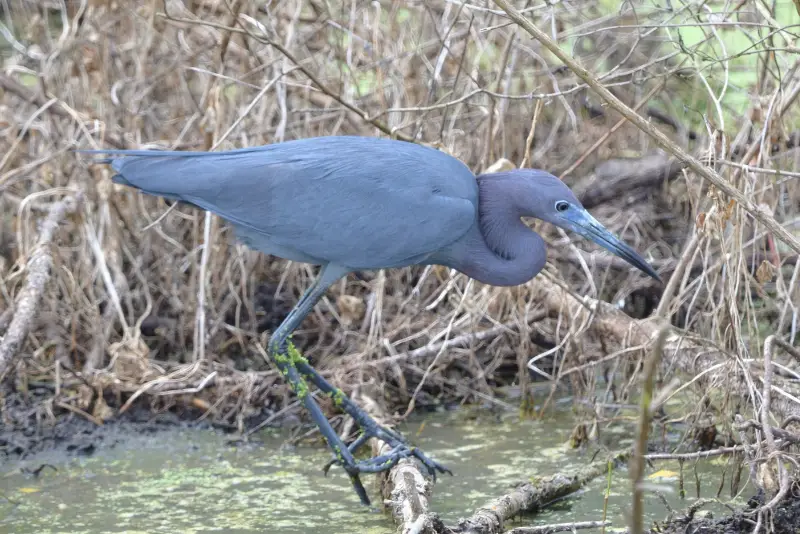
While adult Little Blue Herons are slate blue, young birds are entirely white during their first year.
These small herons are common breeding birds of Florida that can be seen year-round.
During winter, their numbers swell in the state, due to birds from further north wintering in Florida. At this time they are sometimes observed together with reddish egrets.
These herons feed on small fish, mollusks and crustaceans, with crayfish forming a large part of their diet.
They prefer aquatic habitats, where these birds hunt by wading in shallow wetlands, and are only rarely seen away from bodies of water.
Cattle Egret
Scientific name: Bubulcus ibis
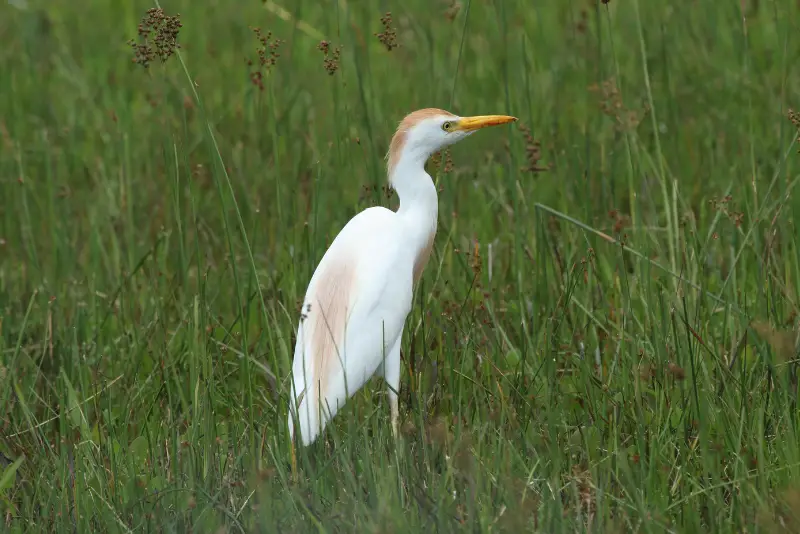
Smaller than Great Egrets, Cattle Egrets have shorter necks and are mostly white with streaks of brownish orange on the head, throat, and back.
The Cattle Egret is a relatively new species in the New World that originated in Europe and Africa.
These water birds are an invasive species in Florida
Nobody knows how these herons crossed the Atlantic, but they were first discovered breeding in Brazil, and later in Florida, where these birds first appeared in late 1955.
They inhabit a wide range of wetland ecosystems, ranging from shallow saltwater zones to freshwater ponds, swamps, and lakes.
Snowy Egret
Scientific name: Egretta thula
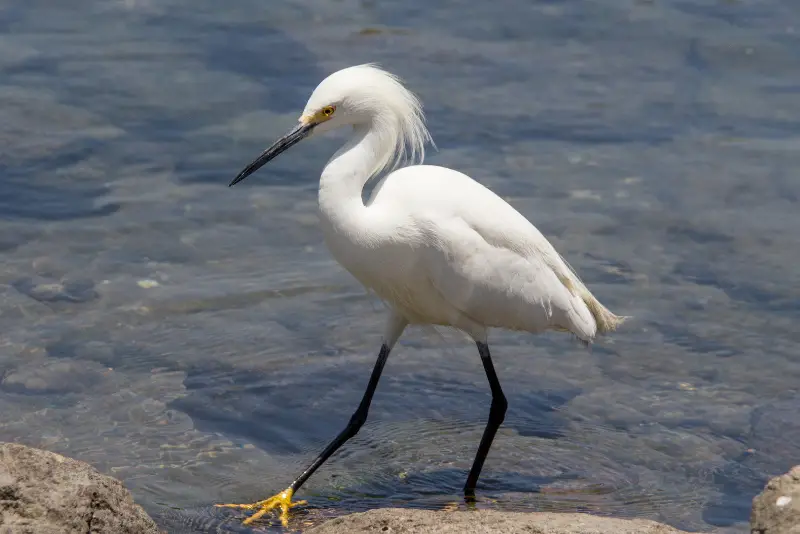
The Snowy Egret is another bird with extensive white plumage that has become an increasingly common bird across Florida.
This bird is found in practically all types of wetland environments, from small ponds to saltwater shorelines and everything in between.
Snowy Egrets feed on fish, crabs, snails, amphibians, and crayfish, which they find in shallow water.
These herons either remain completely still and wait for prey to approach, or they stir up the water with their feet to flush out prey to the surface of the water.
While the Snowy Egret is a breeding bird in Florida, it is much more common in the state during the winter months, when large numbers can be observed in the coastal areas of Florida.
Black-crowned Night Heron
Scientific name: Nycticorax nycticorax
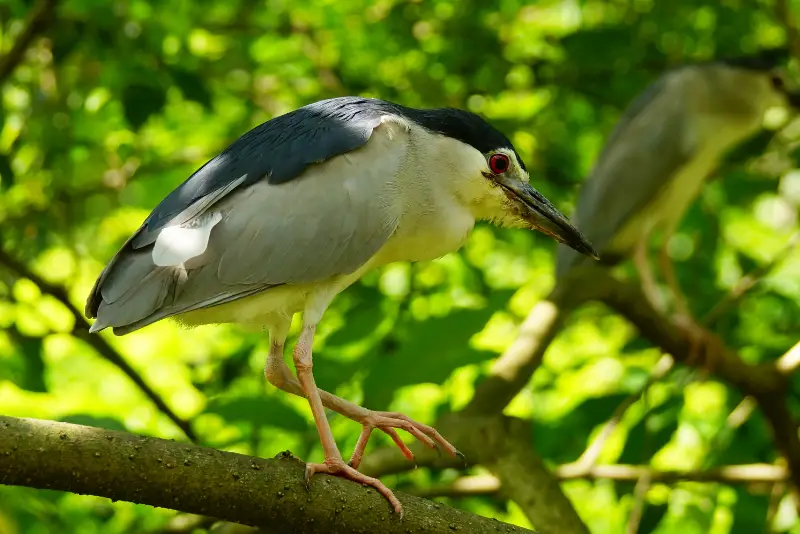
The Black-crowned Night-Heron is true to its name, and is most active at dusk and during the night, when it forages for frogs and small fish in Florida wetlands.
These night-herons are common breeding birds and year-round residents in Florida, though they can be hard to spot during the day, unless you find their daytime hiding spots.
Another great distinguishing feature of these night birds of Florida is their loud squawking sounds, which they utter at dusk when they fly out from their roost.
American Bittern
Scientific name: Botaurus lentiginosus

American Bitterns are small herons that live in marshes and swamps, and are extremely well camouflaged to blend in with aquatic vegetation.
They can blend in with the water plants surrounding them thanks to their mottled brown patterning, as well as the way they hold their heads pointed upwards while remaining still amid the reeds.
American Bitterns eat a wide variety of aquatic organisms, including fish, crabs, insects, frogs, and small rodents.
Least Bittern
Scientific name: Ixobrychus exilis

The Least Bittern is hard to spot, since it usually remains hidden in dense reed beds. The best way to identify one of these herons is by its coo-coo-coo call.
The best places to see these herons are marshes and wetlands with dense vegetation, where they can be observed hunting at the water’s edge.
Least Bitterns feed on fish, amphibians, molluscs, insects, and even rodents.
They forage by grasping individual reeds with their talons while waiting for small aquatic animals to pass by in the water underneath them.
White Ibis
Scientific name: Eudocimus albus
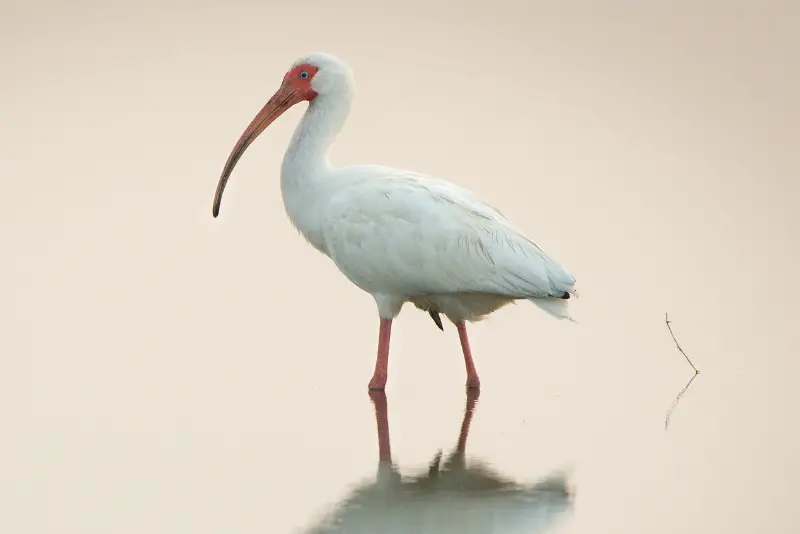
This species is easy to recognize due to its entirely white plumage and long vividly orange colored beak that is curved downwards.
While it is most commonly found in coastal areas, the White Ibis prefers to forage in freshwater habitats.
This bird feeds on insects, crayfish, crustaceans and small fish. Crayfish form a large part of its diet in areas where they are common.
These birds with long beaks are extremely social, and like to nest in large colonies in forests close to wetlands. In fact, it’s rare to see a solitary White Ibis.
Sandhill Crane
Scientific name: Antigone canadensis
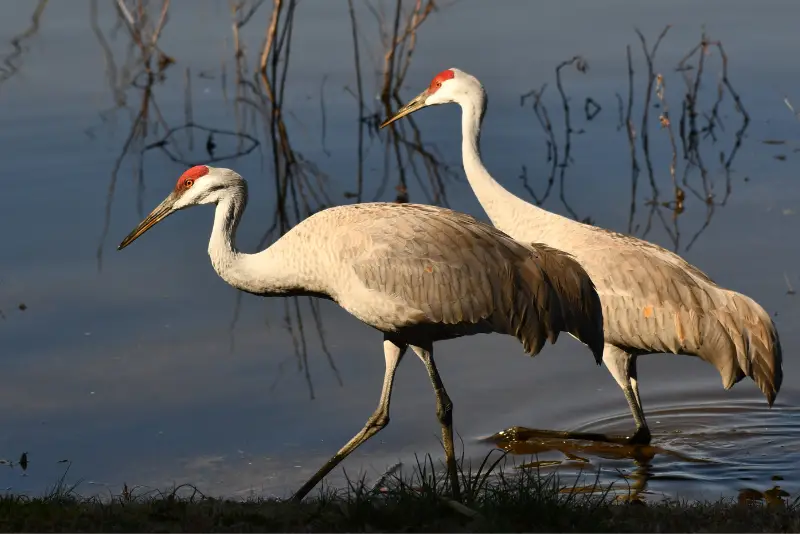
Adult Sandhill Cranes have pale gray body plumage, as well as a red crown and forehead, which contrasts with a buff white cheek.
These large birds are up to 4.5 feet tall, which makes these Florida birds with long legs the tallest in the state.
They are rare breeding birds in northern Florida, and regular winter birds throughout the state..
Sandhill Cranes form large flocks outside of the breeding season, and migrate to southern parts of the USA and Mexico to spend the winter.
Limpkin
Scientific name: Aramus guarauna
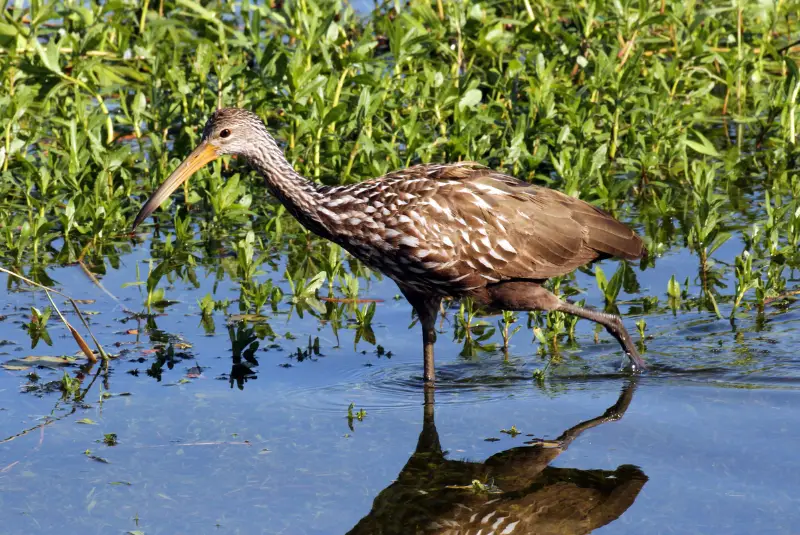
This large Florida wading bird is a year-round resident throughout the state, and can be encountered in a variety of wetland habitats.
Limpkins have a long thick beak, which they use to pry open the shells of mussels and other bivalves.
Apart from their long yellow bills, limpkins are known for their nocturnal calls, where they will cry out mournfully in the middle of the night.
Pied-billed Grebe
Scientific name: Podilymbus podiceps
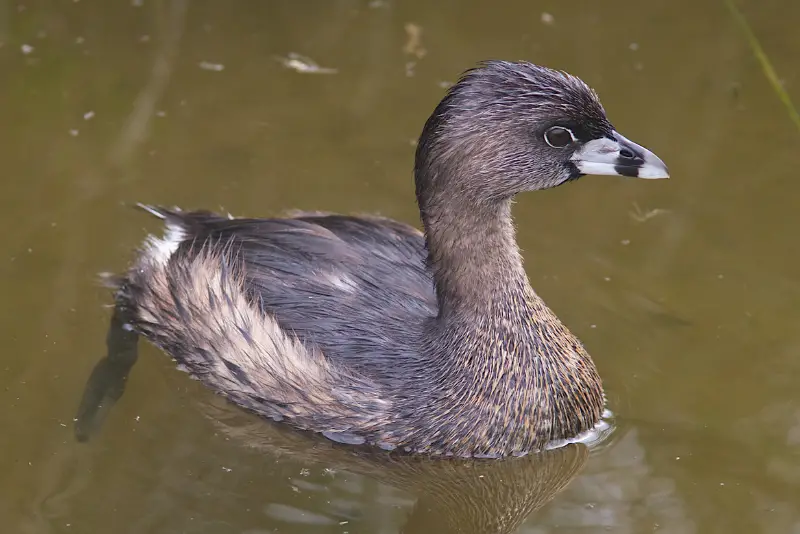
This small diving bird in Florida is easily overlooked, due to its small size and inconspicuous brown coloration.
Pied-billed Grebes are expert divers that hunt fish and other small underwater animals, including small crayfish and insect larvae.
These small waterbirds are widespread and common throughout Florida, where they can be encountered year-round on lakes and ponds with generous vegetation.
Common Loon
Scientific name: Gavia immer
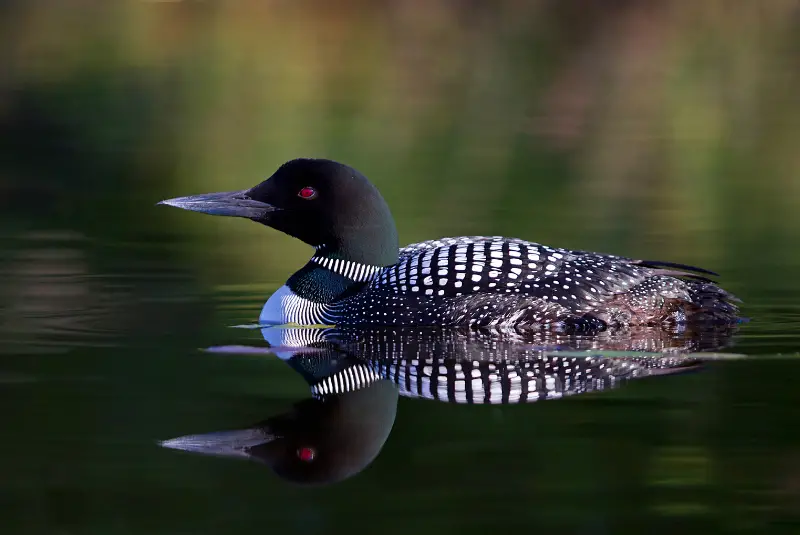
If you’ve spotted a black waterbird with white dots, it is most likely the Common Loon (also known as the Great Northern Diver).
These large water birds breed in northern areas of North America and can be seen along the coastline of Florida during the winter.
The common loon is a fantastic diver and is super stealthy when it hunts underwater, allowing it to sneak up on fish without even a splash. It can dive to depths of up to two-hundred fifty feet.
To top that off, these birds can stay submerged for up to five minutes and even swallow their prey while they are still underwater.
American Coot
Scientific name: Fulica americana
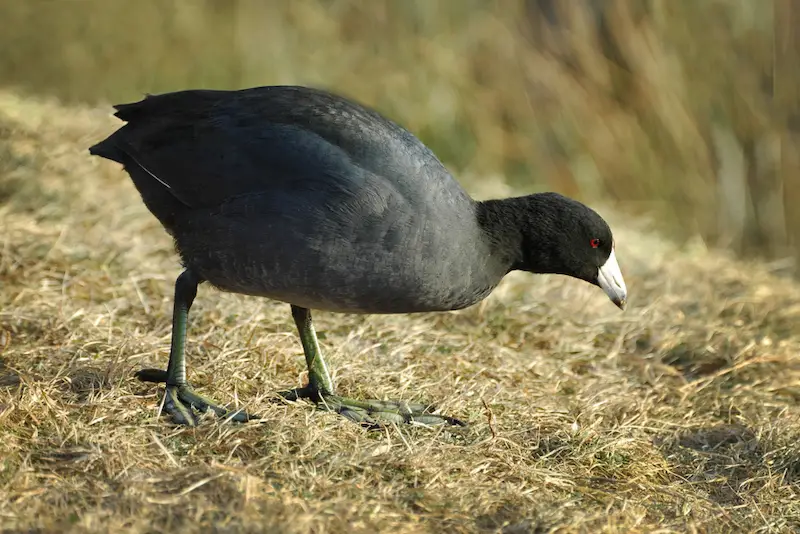
American Coots are regularly observed congregating in huge flocks on open water (especially during migration).
While American Coots are water birds, they don’t have webbed feet like ducks, but instead have broad, lobed toes.
In addition to their ability to swim on top of the water, Coots are also strong divers, and often forage for food on the bottom of shallow lakes and ponds.
American Bald Eagles like to prey on Coots, and will try to tire out an individual by repeatedly forcing it to dive until it is too exhausted and gives up
These black Florida birds may be found in a variety of aquatic habitats, including urban park ponds, reservoirs, marshes, and lake shores.
Common Gallinule
Scientific name: Gallinula galeata
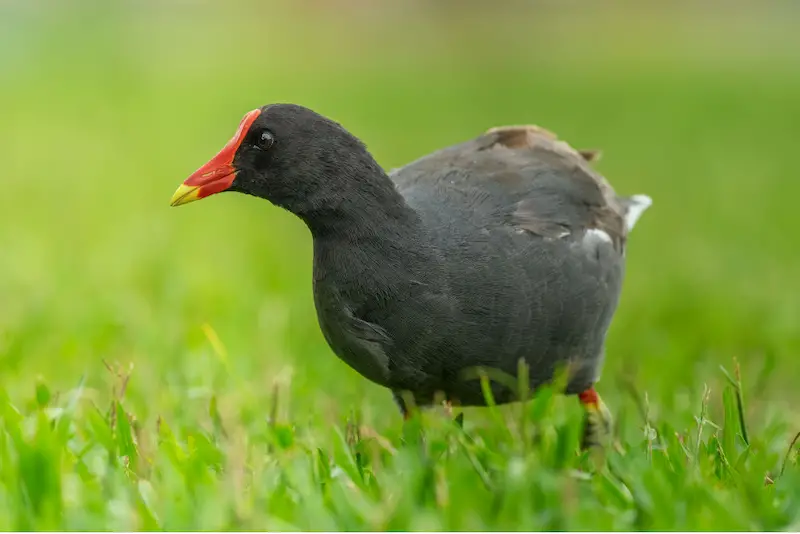
The Common Gallinule is a medium-sized marsh bird with relatively long legs and toes.
Both the male and female have a charcoal body color with a white stripe running down the side, and their outer tail feathers are also white.
Common Gallinules can swim in the water like ducks or geese, and are also able to walk on top of floating plants.
These rails usually remain in close proximity to the protection offered by marsh plants, although they sometimes swim in open water.
Double-crested Cormorant
Scientific name: Phalacrocorax auritus
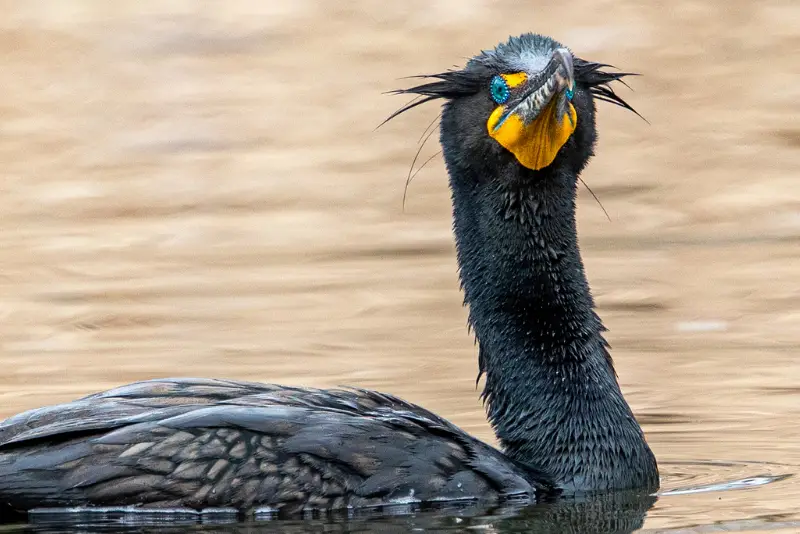
The Double-crested Cormorant is a large, dark waterbird with a long neck and blue eyes. It is a year-round resident in Florida, and is commonly found on coastal waters.
This cormorant likes to gather in large flocks that roost on trees close to water. It is a skilled diving bird and hunts fish with its large, black bill.
When a group of cormorants flies together, they like to form up in V shaped formations, which can be seen in the evening, when the birds fly to their roosting spots in Florida.
Anhinga
Scientific name: Anhinga anhinga
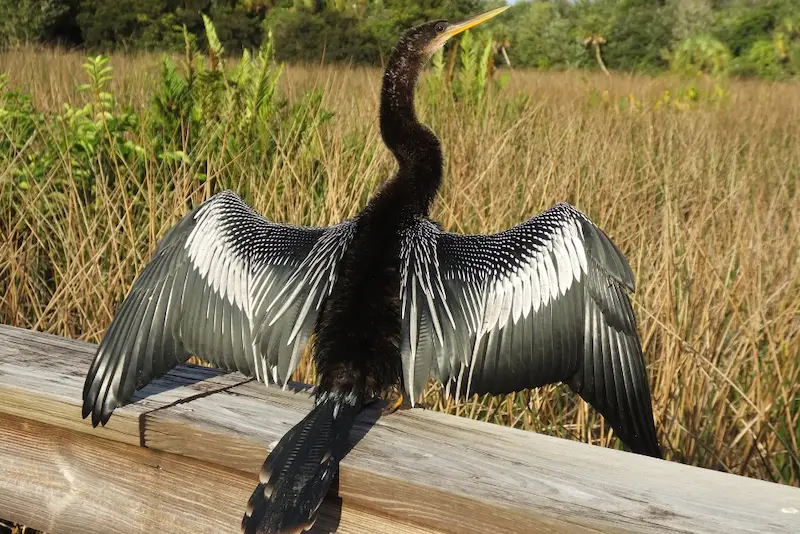
The Anhinga looks similar to a cormorant, but has a snake-like neck, which it uses to catch fish underwater.
When it is in the water, they swim with their bodies submerged, and it’s common to see only the head and neck protruding above the water surface.
Adult male Anhingas are almost entirely black, while females have a dark brown head and neck, as well as black body plumage.
This bird lives in swamps and freshwater ponds, and is a year-round resident in Florida.
Brown Pelican
Scientific name: Pelecanus occidentalis

Brown Pelicans are the most common pelicans found in Florida, where they dive for fish by plunging head-first into the water.
Adult Brown Pelicans are grayish brown with a dark belly, and can be easily recognized by their massive bill.
While this pelican species was endangered a few decades ago due to pesticide poisoning, it has now recovered and is once more a common breeding bird and year-round resident in the state.
American White Pelican
Scientific name: Pelecanus erythrorhynchos
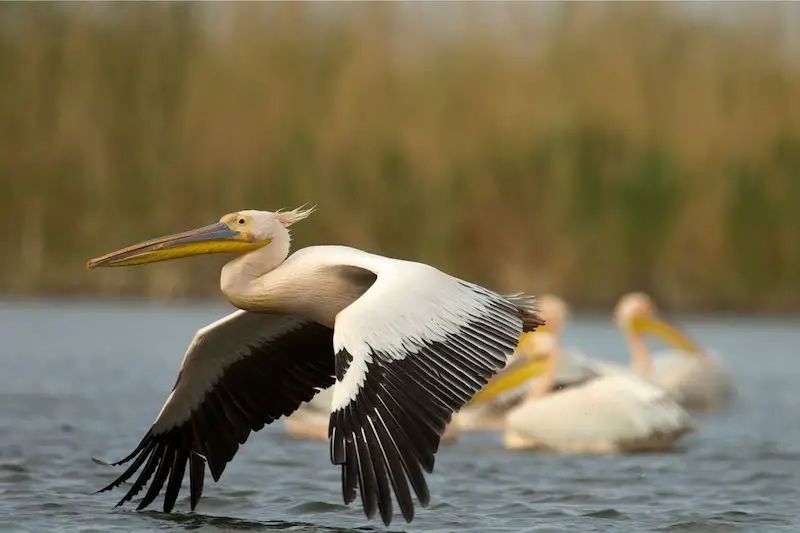
The American White Pelican is the biggest bird in Florida, and is a lot bigger than the Bald Eagle.
American White Pelicans are only observed in Florida during the winter months, as they make Florida their home during the cold season.
Its preferred habitat in Florida are estuaries, shallow bays, and coastal inlets, as well as freshwater lakes further inland.
This bird feeds almost exclusively on fish, but unlike other pelican species it doesn’t dive in order to catch them. Instead it submerges its head down into the water, and grabs fish with its big beak.
Belted Kingfisher
Scientific name: Megaceryle alcyon

Adult Belted Kingfishers are almost entirely teal blue on top, except for a white collar that separates the cap from the rest of the body.
The Belted Kingfisher prefers habitats directly adjacent to lakes and rivers, where it hunts for fish in shallow water by diving headfirst in to catch them.
This water bird species is a partial migratory bird, but can be seen year round in southern parts of its range, including Florida.
This blue-colored bird of Florida feeds almost exclusively on small fish, and is therefore rarely seen far away from water.
Osprey
Scientific name: Pandion haliaetus

The Osprey has a wingspan of up to 69 in (5.5 ft), and resembles an eagle in size.
Ospreys are easy to identify, due to their white underparts and blackish gray upperparts, as well as black wrist patches on their lower wings.
This large Florida raptor is the only bird of prey that plunges into water to catch fish, often becoming entirely submerged in the water as it attempts to grab a fish with its feet.
Due to this style of hunting, Ospreys are almost always found close to water, except during migration, when they will cross areas without water.
The Osprey is a regular though not very common breeding bird throughout the state of Florida.
Final remarks
In summary, here are the 31 different types of water birds found in Florida:
- Mallard
- Mottled Duck
- American Wigeon
- Canvasback
- Northern Shoveler
- Blue-winged Teal
- Wood Duck
- Snow Goose
- Canada Goose
- Great Blue Heron
- Great Egret
- Green Heron
- Little Blue Heron
- Cattle Egret
- Snowy Egret
- Black-crowned Night Heron
- American Bittern
- Least Bittern
- White Ibis
- Sandhill Crane
- Limpkin
- Pied-billed Grebe
- Common Loon
- American Coot
- Common Gallinule
- Double-crested Cormorant
- Anhinga
- Brown Pelican
- American White Pelican
- Belted Kingfisher
- Osprey
If you’ve spotted one of these while bird watching in Florida, but aren’t sure which species of bird it was, check our detailed bird identification guide above with photos.
If you enjoyed this article, check out our guide to the coastal birds of Florida.
